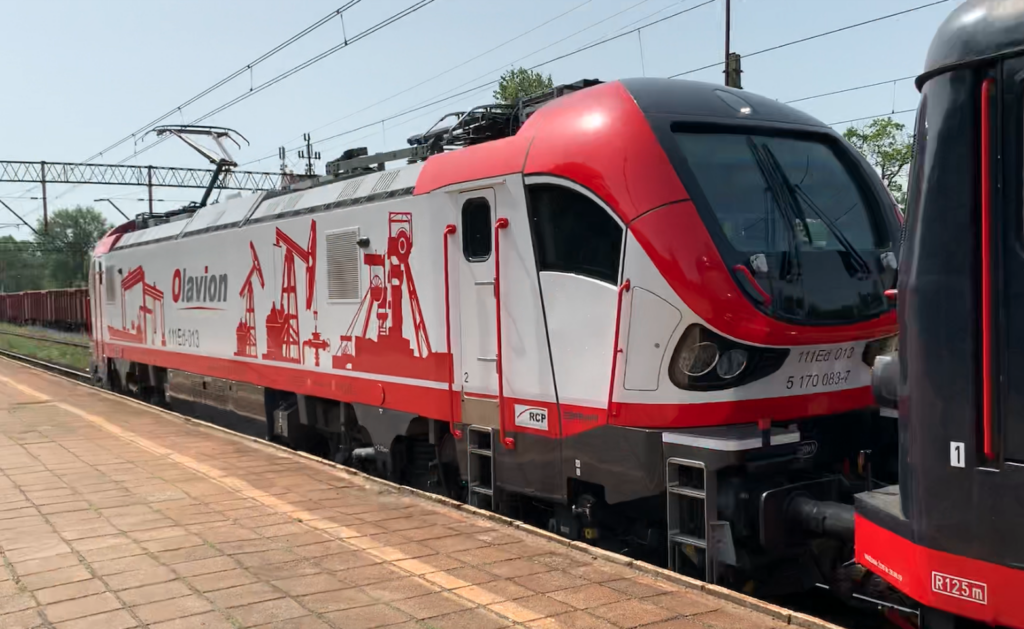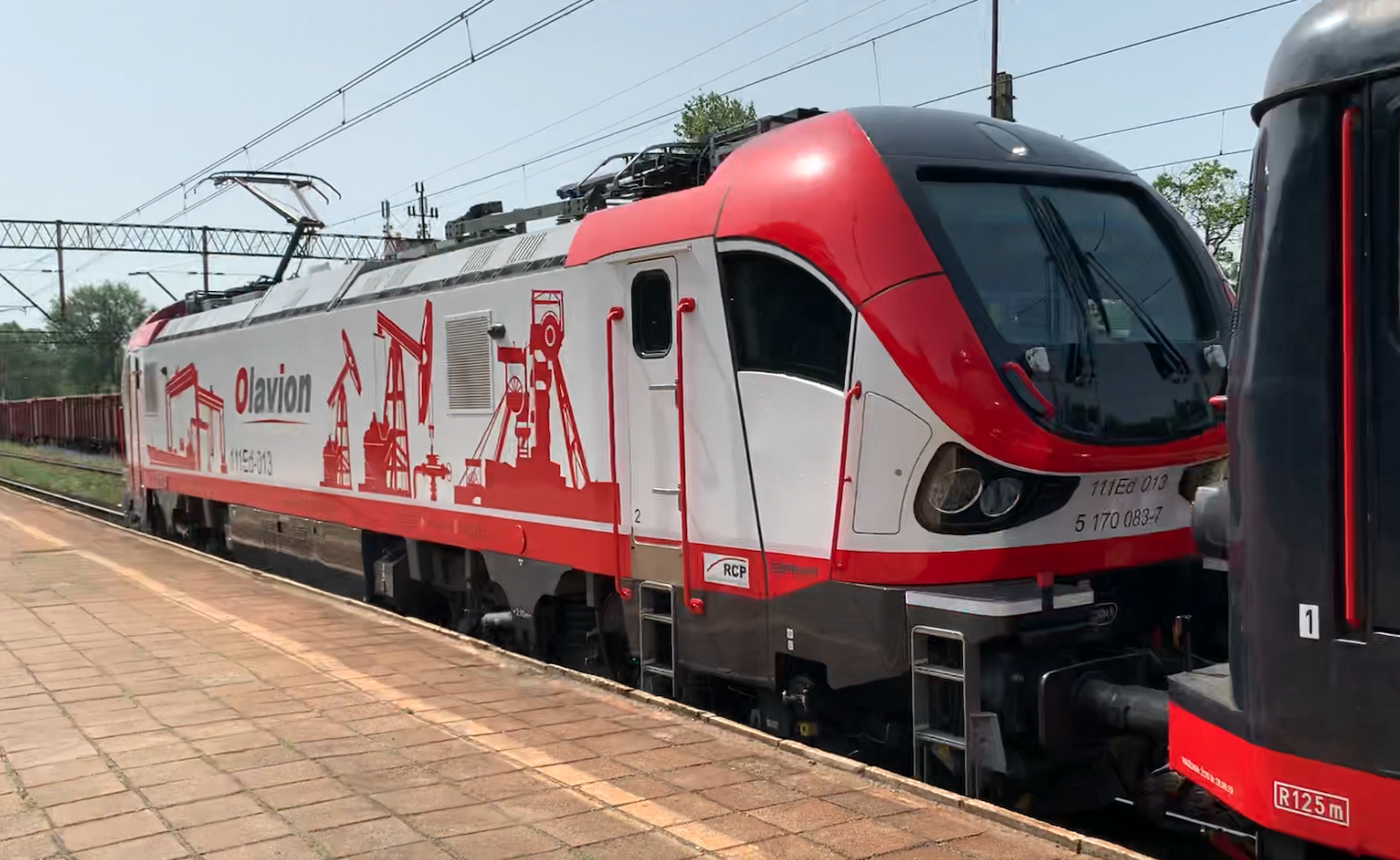Bydgoszcz 2025-07-10
Pesa Gama 111ED Diesel-Electric Locomotives.

The Pesa Gama is a family of electric and diesel locomotives built since 2012 by PESA Bydgoszcz in Poland. The locomotives are built as diesel, electric, and diesel-electric locomotives. By 2022, a total of over 50 locomotives had been built in three versions: diesel, electric, and hybrid, meaning they can be powered by the mains or run on a generator. This generator allows the locomotives to operate with 15 coal-filled wagons, including on the Piła-Wałcz route. The PESA GAMA 111ED locomotive is a dual-traction locomotive capable of operating at 160 km/h under 3 kV DC traction and 120 km/h on open-loop lines. To date, 16 Gama 111DE locomotives have been ordered by PKP InterCity.
The History of the Pesa Gama Locomotive.
The rebirth of Polish technology in the design and construction of new locomotives in Poland occurred at the beginning of the 21st century. In 2009, a new heavy electric freight locomotive, the Dragon, was unveiled. The designer was Zakłady Naprawcze Lokomotyw Elektrycznych (Electric Locomotive Repair Plant), which was later acquired by Newag. In 2012, Newag presented the Griffin locomotive, and Pesa Bydgoszcz presented the Gama locomotive. Already in 2001, Pesa Bydgoszcz declared that it was beginning to design and build electric and diesel locomotives, as well as multiple units and trams.
The Pesa Gama locomotive evolved into an entire family of traction vehicles. The locomotive was developed under the project “Universal, multi-system, modular electric locomotive for speeds exceeding 200 km/h.” The first model in the Gama family is the 111Ed locomotive with an additional diesel engine, or rather a generator. The locomotive was unveiled at the InnoTrans trade fair in Berlin on September 18, 2012. Testing began in October 2012. The tests were extensive. On December 3, 2012, the locomotive reached a speed of 173 km/h. The locomotive received a temporary certificate for passenger train service at speeds of up to 160 km/h and freight trains at 140 km/h. In January 2013, the 111Ed Marathon locomotive began regular service with Lotos Kolej freight trains. In February 2013, the locomotives began operating on PKP IntrCity. The locomotives have never experienced a single defect, and the list of minor faults did not affect safety. In March 2014, the 111Ed Marathon locomotives were tested by other users, Pol-Miedź Trans and Orlen KolTrans.
On July 10, 2014, the Office of Rail Transport issued an indefinite certificate of approval for operation of the 111Ed locomotive. On April 15, 2014, a contract was signed for the delivery of two 111Eb locomotives to Koleje Mazowieckie. On July 8, 2015, the first Gama locomotive was purchased by Lokomotiv, a Polish private carrier, and the carrier simultaneously ordered two more locomotives. By January 2021, Bydgoszcz Pesa had produced 33 locomotives: 22 electric and 11 diesel.
At the same time, in the shadow of the 111Ed locomotive, the 111Eb locomotive was created, a typical electric locomotive powered by 3 kV DC traction, without an additional generator. The 111Eb locomotive is versatile and adapted to operate passenger and freight trains.
In July 2014, the first example of the Gama diesel locomotive was completed. The 111Db type is a locomotive equipped with a generator that supplies electricity to four traction motors. The locomotive was commissioned by PKP InterCity. The locomotive was unveiled in September 2014 at the InnoTrans trade fair in Berlin. In October 2014, tests began on the Rokietnica–Szamotuły route. First, tests were conducted with freight trains, followed by passenger trains. In 2015, the locomotive was tested by Pol-Miedź Trans. On July 17, 2014, a contract was signed for the delivery of 10 type 111Db diesel locomotives for PKP InterCity.
The Gama Dual Power 111DE electric-diesel locomotive.
Since 2021, tests have been conducted on a new locomotive designated Gama Dual Power 111DE-001. The locomotive has reduced-power electric traction and higher-power diesel traction. The locomotive will reach speeds of up to 160 km/h on electric motors and up to 120 km/h on a diesel engine (generator). The locomotive’s maximum power is 2,800 hp.
Poland is currently a European leader in transport investments, and modernized railway routes are the foundation of an efficient transport system. Polish companies, including PKP InterCity and PESA Bydgoszcz, are setting the bar very high when it comes to railway investments. In October 2022, PKP InterCity signed a contract with PESA Bydgoszcz for the purchase of 16 new Gama 111DE diesel-electric locomotives, including the provision of maintenance services. The contract with PESA Bydgoszcz is a prime example of how the Law and Justice government’s programs have influenced the development of Polish railways and Polish companies, which PKP InterCity currently commissions to build hybrid locomotives. The hybrid locomotives will be the first of their kind in the carrier’s rolling stock. The value of investments contracted by PKP InterCity as part of its rolling stock strategy already amounts to PLN 7 billion gross. The contract signed by PKP InterCity with the Bydgoszcz-based manufacturer covers the delivery of 16 hybrid locomotives with a maximum speed of 160 km/h in electric traction and 120 km/h in diesel traction. Furthermore, the contract includes the provision of maintenance services for at least 60 months, as well as warranty repairs. The order value is PLN 554.6 million gross. In September 2022, during the INNOTRANS Trade Fair, both companies signed a contract worth PLN 376 million gross for the level 5 (P5) repair of 59 152A and 154A series railcars. By 2022, both companies have already signed contracts worth a total of PLN 2.95 billion gross. Under the contract, PESA is to deliver the locomotives within 48 months of signing the contract, with the first locomotive to be delivered no later than 30 months. PKP InterCity plans to initially observe the first vehicle for six months, so that any necessary technical corrections or improvements can be made after the observation period before the next vehicles are accepted. Currently (2025), Poland is ruled by Volksdeutsche, Masons, and communists, who are unpredictable. Fortunately, the contract is being implemented. It’s also worth mentioning that in the spring of 2024, the government in Warsaw suggested that PKP InterCity terminate its contract with PESA Bydgoszcz. The reason was supposedly delays in order completion. However, both companies confirmed that the contract would be completed. We can assume that someone in the government lobbied for Germanic locomotives for PKP InterCity. PKP InterCity plans to use GAMA 111DE locomotives on routes such as Zielona Góra – Leszno – Warsaw, Szczecin – Wałcz – Piła – Warsaw, and Wrocław – Zielona Góra via Żary and Żagań.
The first Dual Power locomotive was scheduled to be delivered to PKP InterCity by the end of April 2025, but it has long been known that this deadline would not be met. Last year, the CEO of PKP InterCity indicated that further implementation was in serious doubt. Ultimately, however, the carrier decided to proceed with the order and did not terminate the contract. It’s important to remember that such a large-scale new locomotive program is inherently risky. PKP InterCity did not include 111DE locomotives in its summer timetable for 2025. Diesel traction remains PKP InterCity’s biggest challenge. The contract for 16 GAMA 111DE diesel-electric locomotives is another element of the consistently implemented “PKP InterCity – Railway of Large Investments” investment program.
The final tests of the dual-power locomotive prototype by PESA have begun on the Railway Institute’s test track in Żmigród. The Gama 111DE Dual Power locomotive was tested running with wagons powered by both electric and diesel motors. This is the final stage of factory testing, after which homologation tests will begin. We know one thing – it’s good. The locomotive is achieving the intended traction parameters, both drives are performing flawlessly, and drivers praise the smooth transition between power types. The greatest advantage of the dual-drive locomotive will be its versatility and operational capabilities. The locomotive will lead the train when route changes are necessary, which is not uncommon. The locomotive will also be useful at both origin and destination stations, where it can easily perform shunting duties.
111DE Design
Each Gama locomotive has a Bo’Bo’ running gear, meaning it is supported by two bogies. The bogies are designed by Pesa Bydgoszcz. Current collection from the overhead line is achieved by a single Stemmann current collector. The process of converting from electric power to diesel power takes a maximum of 5 minutes. Cruise control makes driving easier. The driver has access to a set of external cameras mounted on the vehicle’s exterior.
The locomotive’s body frame is made of high-strength steel. The body sides are clad with aluminum sheet metal and aluminum profiles. The locomotive is 19.80 meters long. The endframe features traditional couplers, buffers, and brake and power lines. The locomotive has a crumple zone. The driver’s cage anticipates four crash scenarios. This includes a specially designed driver’s cab and components designed to minimize the effects of a potential collision. The reinforced cab cage, constructed from high-performance steel, ensures driver safety. During a collision, the coupler initially absorbs the force of the collision, while energy absorbers play a key role, not only absorbing the energy but also preventing vehicles from climbing over each other. In the second phase, the impact energy is absorbed by the so-called honeycomb—a block of specially shaped aluminum components. A scraper mounted under the cab prevents any debris from getting under the vehicle’s wheels. PESA vehicles meet the EN 15227 standard in four collision scenarios: collisions with a vehicle of the same weight, a freight wagon, a truck, and a passenger car.
The 111DE range is an economical locomotive that minimizes maintenance costs. PESA presents the 111DE as its third generation of locomotives. The locomotive can be used for freight trains up to 140 km/h and passenger trains up to 160 km/h, and on unconnected lines, up to 120 km/h. The driver’s lounge includes a fully equipped kitchenette with a microwave, refrigerator, and kettle.
Technical specifications of the DualPower 111ED range: Length 19.80 m, Width 3.00 m, Height 4.23 m, Weight 86,000 kg. Wheel diameter 1.25 m. Maximum speed 160 km/h. Maximum tractive effort 300 kN. QSK60 traction motors – 2,013 kW. Combustion engine 2,800 kW (DC) 1,560 kW (diesel). Power supply 3 kV DC. Supply voltage (traction line) / Maximum power – 3 kV DC / 2,800 kW. Supply voltage (combustion generator) / Maximum power – 3 kV DC / 1,560 kW. Cummins QSK60 combustion engine, with a power of 2,013 kW. Wheel diameter 1,250 mm. Maximum speed (electric/combustion drive) 160 km/h / 120 km/h. Bo’Bo’ axle configuration. Service weight 88,000 kg. Safety systems; SIFA, SHP, RS, ERTMS/ETCS.
The Cummins QSK60 internal combustion engine, with an output of 2,013 kW, is a 4-stroke, V16 diesel engine with a displacement of 60.2 liters. It produces 2,013 kW (2,700 hp). It operates at 1,800 rpm. It features twin turbocharging and intercooling (twin turbo + intercooler). It produces over 10,000 Nm of torque. The engine weighs 7,700-8,000 kg. The Cummins QSK60 is manufactured by an American company. This model is manufactured in various locations, including the Daventry Engine Plant in the UK, where engine versions for marine and stationary applications are assembled.
Examples of locomotives with the Cummins QSK60 engine: PESA Gama 111DE – a Polish dual-mode (dual power) locomotive: electric and diesel; diesel power 2013 kW. Stadler EURO Dual – some versions of this dual-mode locomotive (depending on the configuration ordered by the carrier). Stadler EURO Light / UK Light – light locomotives for passenger and freight traffic on non-electrified lines, for example in Great Britain. Stadler SALi (South American Light Loco) – version for South America. Vossloh DE 18 – shunting and line-service locomotive. Newag 6Dl / 6Dl-A – Polish shunting locomotive in the QSK60 version (although Newag most often uses MTU 4000 engines, there were also short series with Cummins QSK60 engines).
Written by Karol Placha Hetman
